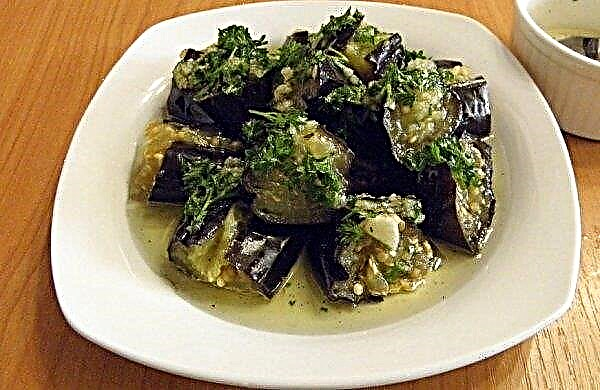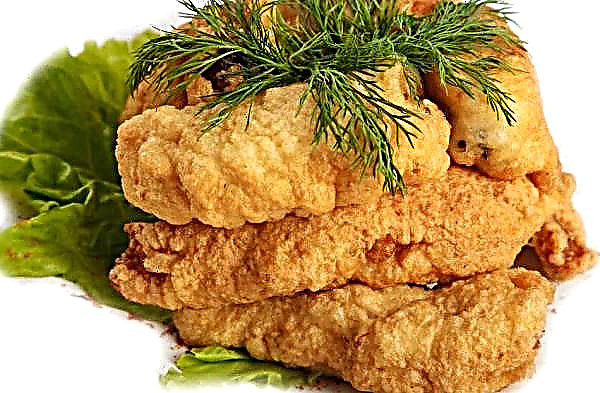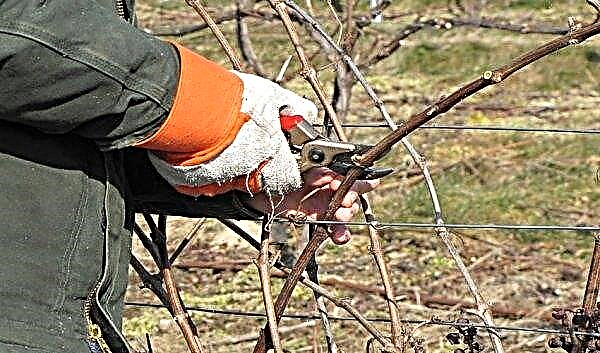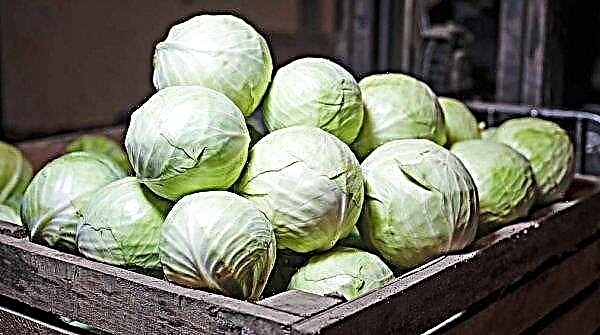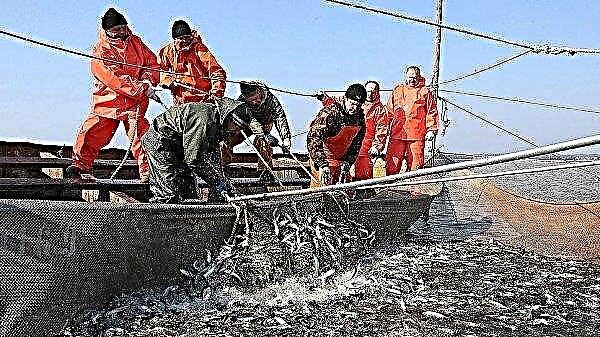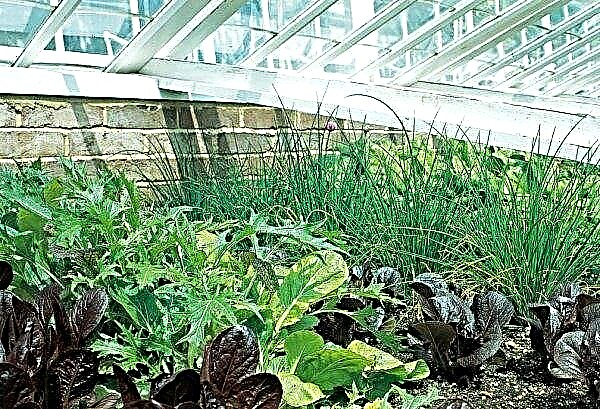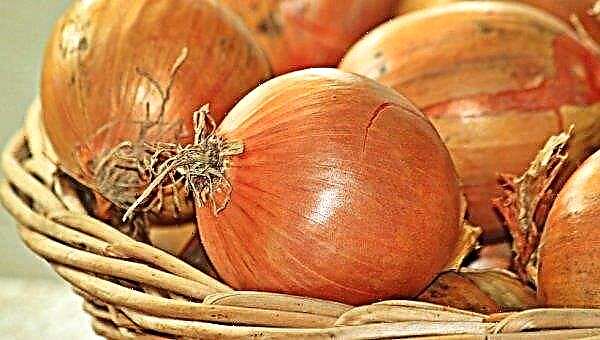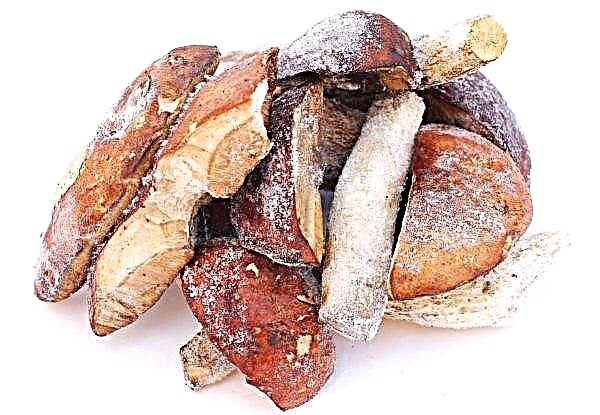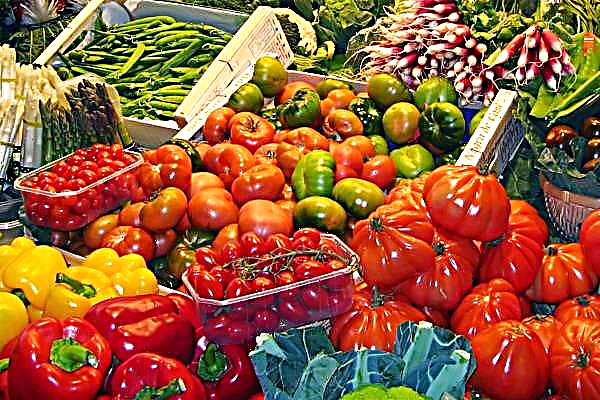Despite the fact that the onion has a specific smell and a bitter taste, it is also susceptible to attack by various pests, which can damage the leaves or the bulb itself. In this article, we will consider the characteristics and description of the most common pests of onions, symptoms of their appearance on the plant, as well as methods of dealing with them using folk remedies and agricultural techniques.
Onion pests: description and symptoms
Pests of green onions are various types of insects that can lay eggs on the surface of the plant or in the soil around it. The plant is harmed by both adult insects and their voracious larvae. After an attack of pests, weakened onions often cause various diseases that lead to a complete loss of yield.
Did you know? Onions contain about 6% sugar. During frying, onion slices lose all caustic substances and become sweet in taste.
But the size of onion pests is very small, so it is not easy to detect their invasion. To do this, you need to know the characteristics of the appearance of insects and their larvae, as well as the symptoms that signal their appearance on the beds.
Root tick
It is not easy to find this pest right away, since it lives in the root part of the plant and feeds on a bulb located in the ground. The root tick can also attack dug bulbs, slowly destroying them from the inside, as a result of which the harvested crop is not stored and begins to rot.
A description of the root tick is presented below:
- The body of adults is oval and can reach 1.1 mm in length. The color of the pest can be white or yellow, on the front of its body is a small rectangular shield.
- The oral apparatus of the insect belongs to the piercing-sucking type, with its help the tick sucks the juice from the plant.
- The extremities of the tick are brown, and their lower part is equipped with claws and spikes. Adults have 8 legs.
- The eggs are white and oval. The female lays them in the tissue of the bulb, where they mature within 2-3 weeks.
- The larvae in body structure are similar to adults, but they are smaller and have 6 limbs of brown color. After about 3 weeks, the larva turns into an adult, which also begins to suck out the juice from the bulb.
Important! In adverse conditions, the root tick can fall into a state of rest. At the same time, it does not grow and does not eat, but when it enters a favorable environment, it returns to life again.
Signs of onion damage by the root tick include:
- the bottom of the bulb dries and falls away;
- a white coating appears on the leaves of the onion;
- the green mass begins to turn yellow and dry;
- bulbs are deformed and become dried;
- the stem and roots of the plant begin to mold and rot.

Onion grub
Although this pest does not appear often, it can cause serious damage to the onion crop. Insects infect the plant in the second half of its growth and cause damage directly to the bulbs.
Characteristics of onion beetles are presented below:
- The insect in appearance resembles a fly. Females have a trunk up to 7 mm long, males up to 6 mm.
- The body of the pest is painted in a bronze-green color, on the back there are two gray stripes. The abdomen of males is slightly swollen, while in females it is flat.
- The extremities of the insects are dark in color with thickened hips of the hind legs. There are black antennae on the head.
- The flight of insects falls at the end of May. An onion bug lays white oblong eggs on bulbs or in soil near plants. Egg size does not exceed 0.8 mm. Larvae appear in 5-10 days.
- The larvae are worm-shaped and reach 1.1 cm in length. Their body is wrinkled, has a dirty white color. The development of the larva lasts about 30 days.
- Pupa formation occurs in the topsoil around the damaged plant. The pupal phase lasts up to 2-2.5 weeks, and then the second generation of insects appears.
- The pest hibernates in the soil in the form of larvae that pupate with the onset of spring.
Did you know? In order to strengthen your immunity in the cold season, it is enough to eat half a small raw bulb daily.
Signs of damage to the plant with an onion sheen are listed below:
- growth retardation;
- yellowing of the tips of the leaves;
- wilting green mass;
- the onion becomes soft, and its middle turns black;
- with severe damage, rotting of the onion begins, accompanied by a characteristic unpleasant odor.

Onion fly
This pest infects onions at an early stage of its growth, and gluttonous larvae can quickly move from diseased plants to healthy ones, overcoming distances of up to 0.5 m.
A detailed description of the onion fly is presented below:
- The body of adult insects is painted in ash gray color, and its length can reach 8 mm. Males have a longitudinal dark strip on the abdomen.
- The extremities of the insect are black, on the hind legs there are short thick bristles.
- The wings are yellowish, oblong.
- The spring flight of insects falls in the second half of May. Insects lay eggs on the green shoots of onions and in the soil around the plants. The egg laying process lasts about 5-6 weeks.
- Pest eggs have an oblong shape, their length does not exceed 1.2 mm, and the color is white. Larvae appear after 3-6 days, depending on air temperature.
- The larvae are painted off-white, their body length is about 1 cm. The front edge of the body is narrowed, and the back and abdomen are rounded.
- Larvae feed on shoots of onions and develop within 2-3 weeks. Then they form a pupa in the soil near the damaged plant, enclosed in a light brown false cocoon.
- The second generation of pests appears in July. In winter, the larvae pupate in the soil, plunging into it to a depth of 20 cm.
Symptoms of the appearance of a pest in onion plantings are:
- group wilting of young shoots of onions in the phase of the first leaf;
- the presence of white larvae at the base of the leaves of the plant;
- small holes on the leaves of the onion and in the bulb itself;
- damage to the neck of the bulb in an adult plant;
- rotting of the bulb.

Stem nematode
This pest is a worm that lays tiny eggs in the pulp of a bulb. Damage to the plant is caused not only by the nematode larvae, but also by adults who drink juice from the plant and provoke its death.
Important! Most often, the stem (onion) nematode damages the root part of the plant and provokes rotting of the bulb.
The characteristics of the pest are presented below:
- The body of the onion nematode is elongated, filiform. Its length is from 1 to 1.5 mm, and the color is yellowish-white.
- On the front of the body there is a mouth cavity with a spear, with the help of which the pest pierces the bulb and sucks the juice from it. The back of the body has the shape of a cone.
- The caterpillar lays translucent eggs inside the bulb and leaves of the plant. Their size is measured by microns, so the nematode eggs are invisible to humans.
- After 3-5 days, larvae appear from the eggs. They have the same body structure as adults, but much smaller in size.
- The process of transforming the larva into an adult lasts 1.5 months. During this time, the caterpillar molts 4 times, and then mates with the male and begins to lay eggs again.

Signs of onion damage by the stem nematode are:
- growth retardation;
- yellowing and drying of onion leaves;
- loose structure of bulbs;
- the surface of the bulb is cracked, and the husk falls off;
- softening and falling of the bottom;
- decay of the bottom of the plant.
Onion weevil
This pest damages onion leaves by piercing them with its long needle-shaped nose. The source of infection can be infected last year plant remains left in the soil.
Did you know? Thanks to the navigator Christopher Columbus, onions came to the territory of America. The sailors first planted this vegetable on the island of Isabella, and then it spread throughout the continent.
Description of onion weevil is presented below:
- The adult insect has a black body, reaching 3 mm in length. In the center of the back there is a white longitudinal strip.
- On the head of the weevil there are short club-shaped antennae with thickening at the ends. The mouth looks like a proboscis with the edge bent down.
- The insect has 6 limbs, which are painted in a dark brown color.
- The female lays eggs in the pulp of onion leaves in the second half of May. They are oval, painted white, and their size does not exceed 0.5 mm. After 10-14 days, larvae emerge from the eggs.
- Caterpillars have an elongated body (up to 7 mm long), painted in yellow. The head of the larvae is brown, and the limbs are absent. Caterpillars gnaw a narrow passage inside the leaf and move into the soil.
- After 14-20 days, the larva turns into a chrysalis, which is in the soil and has a white color, and then becomes brown.
- After 20-30 days, an adult insect appears from the pupa and the cycle repeats. Adult individuals emerging from eggs from the second generation of beetles winter in the upper layers of the soil and become active in mid-April.

Signs of onion defeat by the weevil are:
- small round spots and light strokes on the leaves of the plant;
- uneven edges of leaves damaged by insects;
- yellowing and wilting of green mass;
- slowing plant growth.
Onion moth
Onion moth butterflies can ruin the entire crop of onions on a feather, because lay eggs on leaves from which voracious larvae appear. If you do not notice the pest immediately, then the caterpillars damage not only the leaves, but also the inflorescences of the plant.
Consider the description of the onion moth:
- The insect is a butterfly with a brown body, the length of which reaches 1.5 mm. Wingspan does not exceed 1.7 mm.
- The front wings of the insect are brown with small white markings. The hind wings are painted in beige color, and their lower part is decorated with long villi.
- Onion moth begins to lay eggs in late May. They have an oval shape and are painted yellow, and their diameter does not exceed 0.4 mm. After 7 days, larvae emerge from the eggs.
- The body of the caterpillars is yellow-green, covered with brown warts, and its length is about 1 cm. The caterpillar feeds onion leaves and lives inside their flesh.
- After 2 weeks, the larva transforms into a 0.7 cm long pupa that has a gray color. A pupa is placed on the surface of the plant, and an adult emerges from it after about 3 weeks. Then the cycle repeats first.
Signs of onion damage by this pest are:
- the presence of light longitudinal stripes on the leaves of onions;
- growth retardation;
- yellowing and drying of the tips of the leaves;
- withering of a plant;
- rotting bulbs.

Thrips
This pest can harm the green part of the onion or the bulb itself, sucking out juices from the leaves and root of the plant.
Important! Onions are most susceptible to thrips attack, on the surface of which the pest can enter the repository and cause infection of the entire crop.
Consider the description of onion (tobacco) thrips:
- The body of adults is elongated and can reach 1.3 mm in length.
- The body of thrips is painted dirty yellow or brown. On the back there are two pairs of narrow wings folded along the body. The front wings are smaller and have a darker color than the hind wings.
- The insect has red eyes and yellow antennae. The limbs are black.
- Females lay eggs on the leaves of the plant. They are barrel-shaped and white. The size of a thrips egg does not exceed 0.25 mm. Larvae appear after 4-5 days.
- The larval life span is up to 7 days. The length of her body is up to 0.9 mm, and the color is white or light yellow.
- The pupa has a dark brown color and looks very similar to larvae. This phase lasts 8-10 days, and then a new adult insect appears.

Signs of onion thrips are:
- growth retardation;
- the appearance of white or silver stripes on the green part of the plant;
- curvature and yellowing of leaves;
- small onion;
- withering and decay of the plant.
Aphid
This pest mainly affects shallots, therefore its second name is shallot aphids. These insects have not yet been well studied by biologists, but they can winter in the upper layers of the soil and resume their activity with the arrival of spring heat.
Did you know? Onion juice is an effective pain reliever for bites of bees and wasps, so it is often used for therapeutic compresses.
Consider the characteristic of onion aphids:
- The body length of the pest is about 2 mm. The color of the insect is dark brown, and the shape of the body is drop-shaped.
- The oral apparatus of the insect is of the piercing-sucking type and serves as a pest for sucking the juice from the leaves of the plant.
- In the fall, female aphids lay eggs on the surface of plants, from which larvae appear in the spring, feeding on plant juices.
- Further reproduction is carried out by parthenogenesis. As a result of this, after 3-4 weeks, the insect colony is so large that it is already impossible to save the diseased plant.

Signs of smoldering onions are listed below:
- growth retardation;
- deformation and yellowing of leaves;
- the presence of black powdery coating on the surface of the plant;
- the appearance of ants in rows with onions;
- withering of the plant.
How to deal with pests effectively
A feature of the control of onion pests is that insects and larvae are not recommended to be destroyed with insecticides. Harmful chemicals accumulate in the soil, and the green part of the plants after such treatment becomes unfit for food. Therefore, when growing onions to control pests, they mainly use folk remedies, combining them with agrotechnical methods for the destruction of insects and their larvae.
Agrotechnical control measures
At the initial stage of pest damage, plants can be saved with the help of special agricultural techniques. They require additional labor costs, but help to destroy the larvae and pupae of pests, as well as drive out adult insects from the site.
The main agrotechnical methods of combating the listed pests include:
- planting onions next to beds of carrots and mustard - these plants secrete substances that repel insects;
- planting marigold, mint and marigolds along the perimeter of beds with onionsso that their aroma scares off pests;
- removal of diseased plants from the site and their destruction;
- regular weed weeding and the removal of all plant debris from the soil;
- deep loosening of the topsoil for the destruction of larvae and pupae;
- thinning too dense plantings;
- regular inspection of plants for the presence of larvae or damage from them;
- soil mulching on beds peat crumb;
- watering compliance to avoid waterlogging or drying out of the soil.

Alternative methods of controlling pests of onions
You can get rid of pests and preserve the onion crop with the help of proven folk remedies. The advantage of their use is that they do not pollute the soil, and the plants they process do not change their taste and are safe to eat.
Did you know? One of the most ancient images of the bulb is located in the tomb of the Egyptian pharaoh Tutankhamun and dates from 1352 BC.
Consider the main methods of controlling pests of onions using folk recipes:
- mix 400 g of salt and a bucket of waterand then pour onion with the resulting solution. 3 hours after treatment, water the plants with plain water. The tool helps to get rid of onion gales;
- grind 2 heads of garlic with a little water and leave overnight. Add 0.5 cups of vegetable oil, 1 tsp. liquid soap and 1 liter of water. Stir the resulting solution and spray the diseased plants with it. This tool prevents the reproduction of onion flies and tobacco thrips;
- pour 1 kg of nettle leaves 5 l of boiling water and leave to ferment for 5 days. Dilute the resulting solution with water in a ratio of 1:10 and pour the diseased plants under the root. A decoction of nettles well eliminates the root tick and other pests;
- pour water between the beds of water, and then sprinkle it with a mixture of ground hot pepper and mustard. These spices help eliminate almost all onion pests;
- pour 4 kg of tomato tops 10 l of water and boil over low heat for several hours. Then cool the resulting product and spray the leaves of the plant with it. This tool helps to eliminate the root tick and onion moth;
- pour 200 g of crushed dried chamomile 10 l of water and leave to infuse overnight. The resulting product is filtered and irrigated diseased plants;
- mix tobacco dust and sifted wood ash in a ratio of 1: 2. Sprinkle pre-moistened onion leaves with the prepared dry product. Such a powder helps fight weevil and onion aphids;
- grate 100 g tar soap and dissolve it in a small amount of hot water. Then mix the resulting solution with 10 l of pure water and irrigate the obtained beds with onions with the obtained means. This tool adversely affects the larvae of all pests.

Preventive measures
It is much easier to prevent pests than to control them. Therefore, after harvesting and in preparation for sowing onions in the spring, attention should be paid to measures aimed at preventing the appearance of insects on the site.
Important! It is recommended to plant onions in the garden as early as possible, so that the plant has time to grow stronger by the time pests appear.
Consider the main preventive measures:
- harvested onions must be stored in a dry place at air temperature not higher than + 9 ° С and humidity up to 60%;
- Before storing the crop, it is thoroughly dried and inspected.by removing damaged bulbs;
- premiseintended for storing onions, disinfected with sulfur gas;
- before storing the bulbs, pour over the chalkto stop the development of pests hidden in the tubers;
- crop rotation - onions must not be planted on the same site for two years in a row;
- soil disinfection using a solution of copper sulfate before planting onions;
- before planting the bulbs, they need to be treated with a solutionprepared from 40 g of colloidal sulfur and 10 l of water;
- destruction of all plant residues after harvesting;
- deep autumn soil plowing on the plot for the destruction of pests in the upper layers of the soil;
- compliance with the recommended distance between plants during planting to avoid thickening of the beds.
 Most onion pests are very small, so it’s hard to find them on the beds. The detailed description of insects presented in this article will help to identify the problem at an early stage and eliminate it using the listed methods of control. And the practical application of the listed preventive measures will help prevent the appearance of pests.
Most onion pests are very small, so it’s hard to find them on the beds. The detailed description of insects presented in this article will help to identify the problem at an early stage and eliminate it using the listed methods of control. And the practical application of the listed preventive measures will help prevent the appearance of pests.


